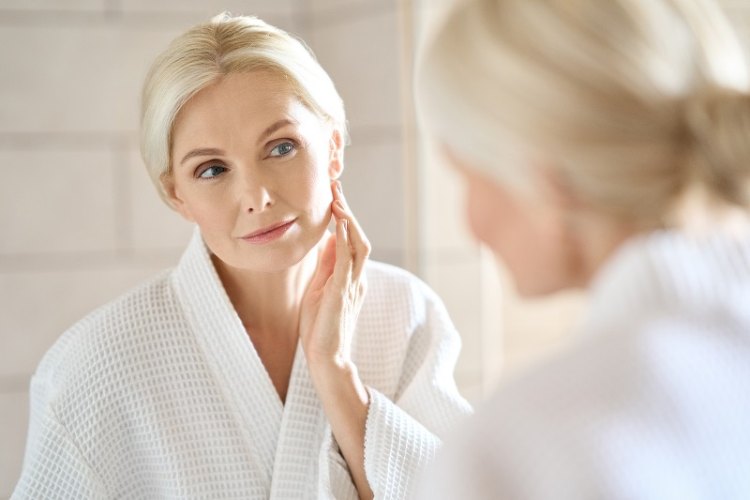Menopausal Skin – The time when your body starts to get ready for menopause is known as the menopausal transition or perimenopause. To name a few, Low levels of the female sex hormone estrogen induce perimenopause, which is characterized by hot flashes, cognitive fog, and a loss of desire. How does it affect your skin, though? It ends up being quite a bit.
Estrogen has been connected to the production of collagen, skin suppleness, thickness, moisture levels, and healthy blood vessels during perimenopause. You might experience wrinkling, dryness, sensitivity, dullness, and sagging if you produce less estrogen.
These modifications even have an impact on skin care specialists like board-certified dermatologists. Yet they don’t wait to take action, and neither should you. During perimenopause, which can start as early as the mid-40s for some women and lasts four to ten years until menstruation ends, estrogen levels decline. The uneven fall, on the other hand, causes unpredictable skin activity. During this stage, you can feel like you’re halfway between a teenager with intermittent breakouts and a senior citizen with severe dryness.
Excessive Dryness and Sporadic Breakouts
Until you achieve menopause, which happens after at least a year without a period, your estrogen levels will continue to decline. You are regarded as postmenopausal if this is the situation. Dermatologists treat these conditions similarly because they all impact the skin in the same manner, even if your skin issues may be less severe during perimenopause and more severe following menopause.
Products for Skincare During Menopause
a hydrating cream cleanser that won’t cause your skin to get overly dry. Cream-based moisturizers may be preferable for dry skin. For results that will make you look younger, try Vivier skin Canadian cosmetics for the face and body. You can repair your skin’s protective barrier using a rich occlusive moisturizer.
Choose zo products containing retinol components when you’re experiencing severe hot flashes. They successfully fight wrinkles and sagging.
Plant extracts fill out the inside framework of the skin. Antioxidants shield your skin from harm, while plant oils give it a healthy glow.
Additionally, there are many things you may do at home to assist in minimizing or even reversing some of the skin changes associated with menopause. Here’s the skinny:
Skin Dryness
Skin seems dull due to dryness from menopause and age-related delayed cell turnover. The hills and valleys are caused by the accumulation of dead skin cells on the skin’s surface. The light reflection from that is not very good. Reflected light gives skin its shine.
To solve the issue, scrub away dead, dull skin. One cannot stress the significance of exfoliation in preserving the appearance of radiant skin. Alpha hydroxy acids (AHAs) can help slog off dead skin to reveal youthful skin. As a humectant, or anything that draws moisture, glycolic acid, or AHA, is fantastic. Use a glycolic-based serum once every two days if your skin can withstand it.
Dryness
A problem with your skin’s outer defense layer is indicated by dryness. As estrogen levels fall, the skin’s epidermis hardens, and oil production is constrained. Dryer skin develops micro tears that let allergens in and moisture out. Skin can become more easily irritated, and inflammatory conditions may become more common.
Employ a mild cleanser that won’t remove the natural oils from dry skin (ideally, a creamy cleanser, not a bubbly one). Finally, to maintain moisture in the skin’s barrier, apply a moisturizer containing ingredients such as ceramides, shea butter, fatty acids, squalene, glycerin, and hyaluronic acid.
Acne
You still have breakouts even though your skin is drying up. How is that even doable? Your female-to-male hormone ratio changes as estrogen levels decrease, causing male hormone levels to increase. One of the most frequent causes of acne is androgens or male hormones. Find out more about Vancouver acne treatment.
Retinol comes to the rescue yet again. Pores stay clear and are less likely to clog and form a pimple since it stimulates cell turnover. Also, you can eliminate breakouts while smoothing skin wrinkles. You could consider a favorable pore reduction treatment if you’re having issues with huge pores.
Sagging
Elastin, the protein that maintains skin taut, and collagen, their partner protein, deteriorate with age. During menopause, elastin loss is particularly significant for women of race. Their issue is skin fragility and drooping rather than lines and wrinkles since their pigment shields their collagen strands from damage.
Sunscreen and antioxidants are essential for avoiding sagging, including vitamins C E and Co-Q10. As estrogen levels decrease, avoiding sun exposure becomes more and more important since estrogen protects against photoaging. Unfortunately, sagging is challenging to repair at home—Ultherapy, a procedure that tightens skin by using ultrasonic pulses. When heated to a specific temperature, collagen contracts, shortening its fibers and tightening the skin.
Fine lines and wrinkles
The cause of this problem is the declining collagen supply. Around 1% of your collagen is lost annually starting in your 30s, but this process considerably quickens after menopause. You lose 30% of your collagen in the first five years following menopause. So, it’s imperative to keep producing collagen while you still have the chance.
The smoothing effects of topical retinoids (prescription or over-the-counter retinol serums) are due to increased collagen production and cell turnover. It is advised to take vitamin C supplements orally and apply vitamin C serum to the skin (500 mg twice daily). Vitamin C, an antioxidant, is necessary for collagen production.
Also read: Microcurrent Facials? Please say yes!
Also read: Hip thrust for glute exercise
